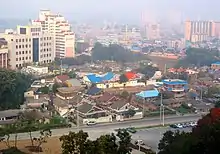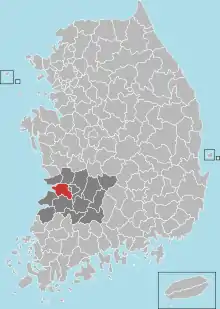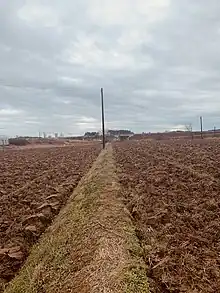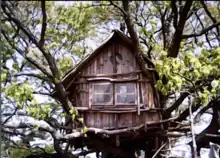Gimje (김제시) is in North Jeolla.
Understand


The area is traditionally one of the most fertile farming areas on the Korean peninsula.
Gimje is Chinese chracter, 金堤. It means gold fields. There is two theories in this title. Fisrt, when the time is fall, rice paddies look like gold color, so that called. Second, The real gold found a lot in gimje at Japanese colonial era.
Gimje City, where you can meet various temples. There are distinctive temples, including Geumsan Temple, which has a unique type of stupa, Manghaesa Temple overlooking the sea, and Gwisinsa Temple with a unique name. It is also good to visit the Arirang Literature Museum, which contains the story of the novel Arirang by novelist Cho Jung-rae.
History
Historically, Gimje-si has been a place where people have lived and built their homes since prehistoric times. In addition to dolmens in Geumsan-myeon, Gimje-si, long stone knives and plates were found throughout the jurisdiction, and fragments of plain-patterned earthenware were found around agricultural land. Through this, it can be seen that agricultural culture was developed from the Bronze Age.
During the Unified Silla period, the name Byeokgol was changed to Gimje. There are records of migrants moving from other areas, which are expected to be due to large fields.
In the Goryeo Dynasty, Gimje was called Buyun and Geoya. Since then, it has become three independent administrative districts and belongs to Jeonju's jurisdiction.
During the Joseon Dynasty, there were significant changes, with a population of about 2,000. At this time, the creation of Hyanggyo brought about the development of education and culture. In 1597, the Battle of Geumgu, which defeated the Japanese enemy heading south during the Jeongyu War, was here. In the late Joseon Dynasty, civil unrest broke out across the country, and hundreds of farmers in Gimje Geum-gu also caused civil unrest by listening to the Samjeong rebellion and the violence of local officials. This leads to the Donghak Peasant Movement.
Climate
Gimje-si has higher winter temperatures and lower summer temperatures than inland areas due to the influence of the sea. The average annual temperature is about 12.8℃, the average temperature in January is about -4.6℃, and the average temperature in August is about 32.2℃. The average annual precipitation is about 1,284mm and the average precipitation in July is 265mm, which is very suitable for rice farming.
| Gimje | ||||||||||||||||||||||||||||||||||||||||||||||||||||||||||||
|---|---|---|---|---|---|---|---|---|---|---|---|---|---|---|---|---|---|---|---|---|---|---|---|---|---|---|---|---|---|---|---|---|---|---|---|---|---|---|---|---|---|---|---|---|---|---|---|---|---|---|---|---|---|---|---|---|---|---|---|---|
| Climate chart (explanation) | ||||||||||||||||||||||||||||||||||||||||||||||||||||||||||||
| ||||||||||||||||||||||||||||||||||||||||||||||||||||||||||||
| ||||||||||||||||||||||||||||||||||||||||||||||||||||||||||||
Get in
Both train stations and bus terminals exist. Since it is a countryside, the interval between city buses is very long. This should be noted. I recommend a private car rather than public transportation.
Get around

See
Gimje is the only place in Korea where the horizon is visible. Therefore, there is also a global festival called the Horizon Festival.
- Geumsansa, ☏ +82 063-548-1390. In fact, it is a temple that any Korean citizen must have heard at least once, because it was a place of misfortune where Gyeon Hwon, the king of Later Baekje, was forcibly detained by his eldest son, Shingum, in the late Three Kingdoms Period in the early Goryeo Dynasty. Free.* Arirang a museum of literature, 24, Yongseong 1-gil, Buryang-myeon, Gimje-si, Jeonbuk, ☏ +82 063-540-3934. Tu-Su 10AM-5PM; open W until 10PM, closed 6PM. The Arirang Literature Museum was built in the Byeokgolje Museum Complex in Gimje on May 16, 2003 to establish Gimje's identity as a place of literature and history in the epic novel Arirang by writer Cho Jung-rae (1943~) and to share the literary spirit and historical consciousness contained in Arirang with more people. Adults: $10, kids free.
Museums
Do
- 🌍 Horizon Festival (김제 지평선축제), Sinnyong-ri, Buryang-myeon, Gimje-si, Jeollabuk-do 전북 김제시 부량면 (Shuttle buses to the Byeokgolje Reservoir). Held late September / early October, this is festival celebrating Korea's traditional farming culture.
🌍 Earthenware Kiln of Bugeo-ri (부거리 옹기가마), Sinnyong-ri, Buryang-myeon, Gimje-si, Jeollabuk-do 전북 김제시 부량면 (Shuttle buses to the Byeokgolje Reservoir). It is a space where pottery was made during the Joseon Dynasty and is making efforts to make pottery again. Anyone can experience pottery, so let's try it.
- 🌍 Guemsansa (금산사), Geumsan Temple, Moak 15-gil, Geumsan-myeon, Gimje-si, Jeollabuk-do (Geumsan-ri 39). It is a temple located at the southwest foot of Moaksan Mountain, Geumsan-ri, Geumsan-myeon, Gimje-si, Jeollabuk-do, and is the headquarters of the 17th parish of the Jogye Order of Korean Buddhism. free.
Eat
The Jeollabuk-do region is a granary area in Honam, and is full of natural ingredients such as high-quality rice from the wide plains and various vegetables and seafood from good soil. Since ancient times, ancestors in the Gimje area have used it to enjoy the taste and style, and have produced many delicious local foods that suit their tastes.
[Steamed Tteobugi] Steamed Tteobugi is cooked with the right amount of Tteobugi, flour, and soy sauce. First, wash and trim the moxibustion well, coat it with a little flour, and steam it with an appropriate amount of soy sauce.
Eat
- 🌍 Daeheunggak (대흥각), 1054-1 Geomsan-dong, Gimje-si, Jeollabuk-do. Daeheunggak, an old Chinese restaurant with a tradition of more than 40 years in Gimje. The traces of time can be seen throughout the store, including red-painted menus and antique chairs.
- 🌍 5-day gimje market. 06AM ~ 11AM / 2PM ~ 5PM. A traditional market refers to a traditional market in which small merchants gather and sell various goods directly. Starting from regular markets held by people such as the 3-day market and the 5-day market, which have been handed down since the Joseon Dynasty, these days, permanent markets with a coalition structure of small merchants are the mainstream. ~.
- 🌍 Urim garden(유림가든) (136-29, Hagong-ro, Gimje-si, Jeollabuk-do), ☏ +82 63-542-0288. 12:00 ~ 21:00. This restaurant is a hidden restaurant. It might be hard to find it because it's in the countryside, but let's make sure to go.
- 🌍 jo's sundae soup(조만영의 벌떡순대국), 151 Nambuk-ro, Gimje-si, Jeollabuk-do (136-29, Hagong-ro, Gimje-si, Jeollabuk-do), ☏ +82 63-920-4311. 10:00 ~ 21:00 (break time 14:30~16:30). You can taste a lot of sundae gukbap and Gimje rice. I recommend it to a big eater.
Drink
[Sikhye] To make sikhye, dissolve the malt powder evenly in the water and leave it for about 3 hours until the top water is clear. Wash glutinous rice thoroughly and soak it for more than 3 hours to steam it on a steamer with a wet dishcloth. Spray water while steaming to mix the top and bottom so that it moxibustion evenly. Pour the starch into the water and discard the remaining residue. Mix 5-6 times the amount of malt water in the hot rice, stir evenly, put it in a thermal rice container, and leave it at a warm temperature of 65°C for about 4 hours. When the rice grains are fermented and float on top, remove the rice grains and rinse them in cold water, transfer the sikhye water to a pot, and boil it with ginger and sugar to cool it down. When eating, put rice grains rinsed in cold water in cold water in a bowl and float three or four pine nuts each.
Sleep
- 🌍 Bamboo garden guest house(죽로원 게스트하우스), 39, Dunaesan 1-gil, Mangyeong-eup, Gimje-si, Jeollabuk-do, ☏ +82 010-9120-4794. It consists of Korean traditional ocher rooms. If you go in winter, you will be able to enjoy the warm floor of the room. ₩80000~120000.
- 🌍 Mizuno's Tree House(미즈노씨네 트리하우스), 49-5 Daedong 1-gil, Mangyeong-eup, Gimje-si, Jeollabuk-do, ☏ +82 0507-1370-7744. It is a house built on a tree. It's a nice guest house with a cafe. It's a choice you won't regret.₩260000.

Connect
Go next
There are Gunsan, Buan, and Jeonju-si nearby, and if you move west, you can go to the sea along Saemangeum.